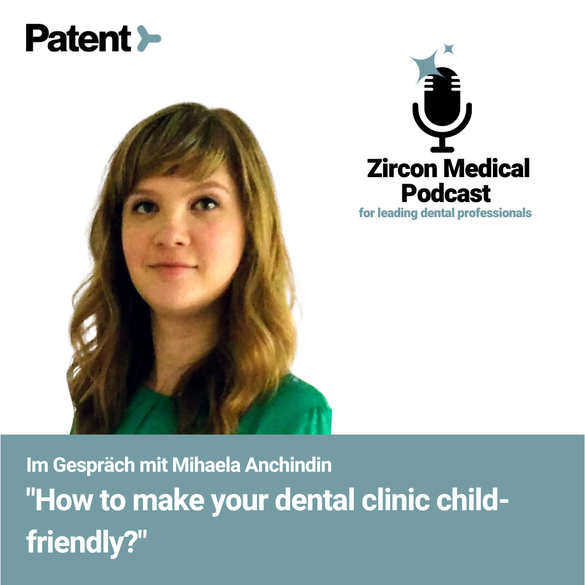
Basic strategies for all dental professionals to take care of younger patients.
See your dental clinic with the eyes of a child.
It's not only you, it's the whole ambiance and your team that makes a child feel secure.
Anxiety-free treatment of children promotes a positive relationship with dentistry when they are adults
Dr. Michaela Anchidin
Pediatric dentist
Deeply interested in child psychology.
Master of Science degree with a special focus on pediatric dentistry.
Her biggest goal is that her patients build a positive relationship with dentistry.
Beginning in February 2021, she will work in a school dental clinic in a rapidly growing community to become even more involved in preventing tooth decay and improving children's dental health.
Wehntalerstrasse 190, 8105 Regensdorf, Schweiz
In Conversation with Dr. Michaela Anchidin
Children aren’t little adults, and treating them isn’t the same as treating adults. Most people understand that intrinsically, but few understand the specific challenges associated with pediatric dentistry.
However, Dr. Michaela Anchidin has made a true art of dealing with children, combining her exceptional dental skills with a keen understanding of child psychology to ensure her pediatric patients trust her and develop a positive relationship with dentistry.
Our team at Zircon Medical recently hosted Dr. Michaela Anchidin on our podcast series to discuss how pediatric dentistry differs from general dentistry, how to make a dental clinic more child-friendly, and some words of wisdom for younger dentists considering pediatric specialty.
Introducing Dr. Michaela Anchidin, the pediatric dentist at Chinderzahni | Praxis für Kinderzahnmedizin.
Dr. Michaela Anchidin is a pediatric dentist currently associated with Chinderzahni | Praxis für Kinderzahnmedizin in Regensdorf. She graduated in 2019 from the University of Ernst-Moritz-Arndt-Universität in Greifswald , where she completed her Master of Science degree with a special focus on pediatric dentistry.
Since then, she has dedicated herself to caring for her young patients, helping them understand the value of dental treatments, maintain optimal oral health, and develop an overall positive relationship with dentistry.
Initially, Dr. Anchidin had been drawn to orthodontics and its complexities, but her interests veered towards pediatric dentistry when she interned at a pediatric practice in Germany during the 5th year of her studies. She was soon overwhelmed by a deep and resounding passion for pediatric dentistry, a passion supported by a range of exceptional pediatric dentists and mentors who willingly shared their cumulative knowledge.
The most rewarding aspect of pediatric dentistry, according to Dr. Anchidin, is that you have a demonstrable impact on children’s future and general attitude towards dental health. Children who come across unfriendly dentists in their adolescent years often take the fear of dentistry into their adulthood, which, in turn, affects their overall dental health. As such, cultivating a healthy appreciation for dentistry is vital.
Word to the wise — children aren’t little adults.
When dealing with children, whether as a pediatric dentist or a general dentist, it’s important to remember that children aren’t little adults or aliens from other planets. Kids often have unique psychological and behavioral patterns that differ from adults. As such, dealing with children is entirely different from dealing with full-grown adults. And you must adapt your attitude to deal with the individual child patient.
Kids are incredibly empathetic — they can accurately feel your emotions, such as joy, happiness, sadness, anxiety, etc. They often imbibe those emotions and reflect them back at you. If you think a child is being difficult, they’re likely to become even more difficult. That’s why it’s crucial to establish a clear mental framework for yourself and actively pursue positive thinking. According to Dr. Anchidin, working with kids is different from general dentistry because you have to focus on their behaviors and feelings more than the treatment steps.
Pediatric dentistry also involves a keen understanding of child psychology to communicate with them clearly. As an example, Dr. Anchidin notes that pediatric dentists should avoid negative constructions, such as “don’t worry, it won’t hurt.” A child is more likely to only hear the words “worry” and “hurt,” making them anxious even if they weren’t anxious previously.
While you should avoid negative constructions, Dr. Anchidin also stresses the importance of striking the right balance — you should also be sincere and communicate honestly to retain their trust.
Dr. Anchidin believes another key difference between pediatric dentistry and general dentistry is the length of treatments. With adults, you can have longer treatments that last for 1 to 2 hours. You can handle multiple molar extractions, for example, in a single extended session to save them multiple trips to the dentist.
But children don’t have the patience necessary for such an extended session — they can usually concentrate for up to 20 minutes at a time. The average session at a pediatric dental clinic is usually far shorter.
Dr. Anchidin firmly believes that pediatric dentists must remember who their patients truly are — the children, not the parents. As such, pediatric dentists must counsel parents when they have unrealistic expectations from their children, ask them to sit in a “silent chair” during the treatment, and advocate for the child’s well-being, even if it goes against the parents’ desires.
As such, pediatric dentistry often includes extended counseling because you have to constantly deal with parents and allay their concerns.
Tips on setting up a child-friendly dental clinic.
Dr. Anchidin firmly believes that a dental clinic must be specifically designed to appeal to children. She recommends that adults should sit on their knees to truly see a dental clinic from a child’s perspective. As adults, we often fail to notice things that might terrify children from their height or perspective.
Observing a dental clinic while sitting on your knees will help you understand how to truly make your clinic child-friendly.
The following are some of Dr. Anchidin’s recommendations on setting up a child-friendly dental clinic:
Lower the height of the reception area so that the child can see the person behind the desk rather than just a large column.
Keep plenty of toys in the waiting area for distractions.
Maintain a library of books in the treatment rooms.
The waiting rooms should have enough space to accommodate the child’s entire family, including the parents, sisters, brothers, friends, etc.
Large treatment rooms flooded with light sources to uplift everyone’s moods.
Build a dental team with members who genuinely love working with children.
Train the dental team in dealing with children.
The receptionist should be incredibly friendly — they’re the first individual the parents and kids will interact with.
The receptionist should be trained to deal with anxious parents and children, handle emergencies, and organize last-minute treatments without delay.
When putting together a dental care team, focus less on skills and more on the potential candidates’ attitudes, behavior, flexibility, and openness.
Tips and tricks for younger dentists and dental assistants.
Pediatric dentistry courses usually include components of child psychology to help you deal with a child’s unique mental framework.
However, it’s not just pediatric dentists who need to understand working with children — each individual in a dental clinic must understand the basics of child psychology. The receptionist, dental assistant, and everyone else must have some basic tips and tricks on managing their pediatric patients, which is why training is crucial.
Dr. Anchidin offers the following tips and tricks on handling pediatric patients:
Communicate clearly in simple terms that the child can understand.
Avoid negative constructions, such as “don’t worry” or “don’t be afraid.” They signal that they have something to be concerned about.
Guide the child towards a positive frame of mind by asking a series of questions with obvious “yes” answers. Examples include “is your name Dominique,” “are you 3 years old,” “is this your mother?” Once the child has said yes to three questions, they’re more likely to say yes when you ask them more important questions, such as, “would you like to sit on the chair?”
Kids cry all the time, but different types of crying have different meanings. Understand why they’re crying and what’s bothering them. Is it the bright lights? Is it the dental instruments? Or something else?
Introduce them to all the instruments you’ll use, so they’re not scared when they see them during the procedure.
The aforementioned tips and tricks will certainly get you started, but Dr. Anchidin emphasizes the need for specialized training and courses. Each member of the dental team should have access to training courses to deal with children more effectively.
On her part, Dr. Anchidin aims to continue improving her management and leadership skills, specialize in endodontics and other connected fields, and advocate for overall oral health and prevention to put an end to childhood caries and other such diseases.
Beginning in February 2021, she will work in a school dental clinic in a rapidly growing community to become even more involved in preventing tooth decay and improving children's dental health.
You can find Dr. Anchidin at Chinderzahni | Praxis für Kinderzahnmedizin, located at Wehntalerstrasse 190, 8105 Regensdorf, she will work there until February 2021. You can also listen to Dr. Anchidin in our Zircon Medical podcast (linked below) or continue reading for a detailed article on making your dental clinic child-friendly.
Register for our free newsletter.
Never miss one of our weekly episodes with leading dental professionals.
How to make your dental clinic child-friendly?
An independent article by the Zircon Medical Team
As our conversation with Dr. Anchidin shows, maintaining a child-friendly dental clinic is imperative. It doesn’t matter if you have a specialized pediatric dental clinic or a general dental clinic that treats pediatric patients; everyone should aspire to make their clinic more child-friendly. Far too many adults are traumatized from their childhood dental treatments, but we must make a concerted effort to change that. Below, we provide crucial tips on developing a child-friendly dental practice.
The reception should be friendly and welcoming.
As Dr. Anchidin pointed out, the reception area is the first thing all children and parents notice when they step into dental clinics. As such, it’s crucial to ensure the reception area and the receptionist are welcoming to children.
Most dental clinics maintain high-walled reception desks that children have to tilt their heads upwards to see completely. That perspective is often scary for young kids, and it puts them in a negative frame of mind that’s hard to shake off later.
The reception area should ideally be brightly-designed, open-planned, and with lower walls. The child should clearly see the receptionist without straining too much. In turn, the receptionist must be incredibly friendly, confident, and trained to deal with children in stressful scenarios.
If parents bring their children into the clinic with a dental emergency, the receptionist should be skilled enough to immediately kick into high gear and take charge.
The reception is where the child starts building their perception of the dental clinic. If they feel welcomed and happy with the reception, they’re more likely to carry that attitude into the treatment.
The waiting area should have plenty of distractions.
Anyone familiar with kids will know that they’re incredibly impatient, incapable of sitting still for 5 minutes at a stretch. When they’re impatient, they either make trouble or retreat into their thoughts, both of which can be problematic. If they have too much time with their thoughts, they might start worrying about the upcoming dental treatment and get into a negative frame of mind, complicating the treatment process.
To avoid that, the waiting period should be minimized through optimal preparation. Your dental clinic must have a clear working protocol to ensure all treatments are fast. That means everyone in the dental clinic should be trained to ensure maximum efficiency.
The treatment room must have all the necessary attendants and tools necessary for the treatment. You should also ensure that you leave some time between two appointments, so the next patients don’t have to wait too long.
Minimizing the waiting period through efficiency is crucial, but it’s not everything. Waiting is an unavoidable part of dental practices, but you can make the waiting period less stressful with a fun waiting room.
The waiting area should have books, magazines, televisions, headphones, toys, fun mirrors, activity tables, board games, aquariums, and other distractions. Your pediatric patient shouldn’t be kept waiting — but if they must wait, they should have plenty of distractions.
Everyone and everything must have an introduction.
Children are naturally inquisitive, and they’re often scared of things and people they don’t understand. The fear is understandable — even adults wouldn’t want strangers poking inside their mouths with sharp metallic objects if they didn’t have context.
Children are no different in that regard — the only way to allay their fears is to familiarize them with their surroundings, establish trust with them and their parents, and explain the purpose behind each tool.
When parents and children come into the dental clinic, the entire staff should introduce themselves to the parents first, followed by the children. The staff should introduce themselves to the parents first to establish trust with the children. When they introduce themselves to the children, they should kneel down to the child’s level. Towering over children during the introduction can make them feel threatened.











